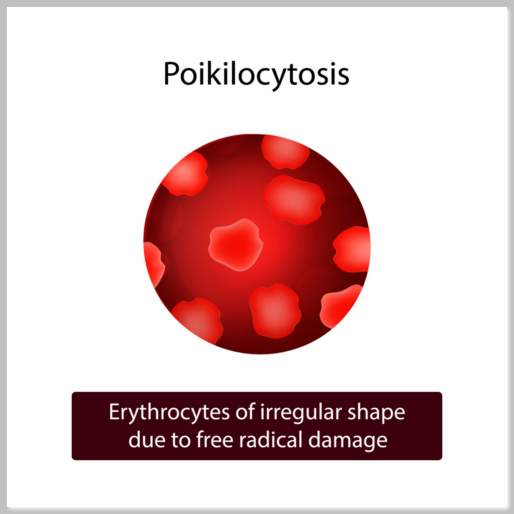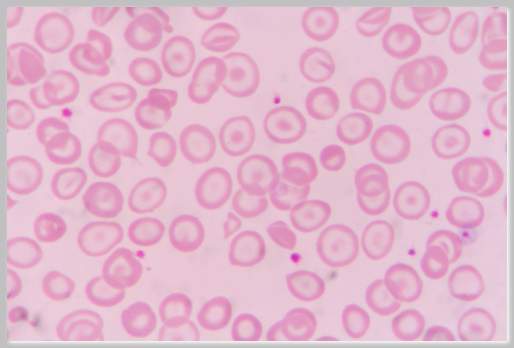Definition of Poikilocytosis

Poikilocytosis is a rare blood disorder wherein there is an increase in the number of poikilocytes in the blood.
Normally, a red blood cell (RBC) has a shape resembling a disk, which is round and flat. Its middle part is also thinner than its edges. When a person has poikilocytosis, he will have RBCs with abnormal shapes.
This blood disorder is a life-threatening condition. Keep in mind that the primary responsibility of the RBC is to carry oxygen and nutrients throughout the body. Abnormal cells are unable to do this efficiently. Thus, it can affect your overall health condition. Nonetheless, this disease is treatable. The first step is to identify the specific cause of the disorder to get the appropriate treatment.
Poikilocytosis Review Table:
There are various types of abnormally shaped RBCs. The table below will show the various types of poikilocytes including the disease or medical condition associated with it.
| Cell Type | Description of the RBC | Associated Medical Conditions |
| Teardrop Cell | · The RBC has a teardrop shape. | · Myelofibrosis |
| Spherocyte | · The RBC is smaller than its normal size, which is six to eight µm.
· The center is not pale. · It has a round shape rather than disk-shaped. |
· Autoimmune Hemolytic Anemia
· Hereditary Spherocytosis · Severe Burns |
| Target Cell | · The RBC has a bull’s eye appearance due to the distribution of hemoglobin. | · Hemoglobinopathies (Sickle Cell Diseases)
· Iron Deficiency Anemia · Liver Cirrhosis · Splenectomy · Some Types of Thalassemias |
| Sickle Cell | · The RBC has a crescent shape.
· It has hemoglobin S. |
· Sickle Cell Disease |
| Stomatocyte | · The RBC has a coffee bean like appearance or a pale thin line in the center.
· It has a cup shape, which is 3-dimensional. |
· Hereditary Stomatocytosis
· Liver Disease · Alcohol-related diseases · Rhnull phenotype |
| Schistocyte
(Fragmented Red Cell) |
· The RBC becomes fragmented or it has no specific shape or size.
|
· Microangiopathic Hemolytic Anemia (MAHA)
· Hemolytic Uremic Syndrome (HUS) · Thrombotic Thrombocytopenic Purpura (TTP) · Disseminated Intravascular Coagulation (DIC) · Severe Burns |
| Ovalocyte
(Elliptocyte) |
· The RBC has an oval, elongated, pencil, or cigar-like shape. | · Hereditary Elliptocytosis
· Myelophthisic Anemia · Megaloblastic Anemia · Some Types of Thalassemia · Severe Iron Deficiency |
| Acanthocyte
(Spur Cell) |
· The RBC has an irregular shape with spikes.
· The center is not pale. |
· Abetalipoproteinemia
· Myeloproliferative Disorders · Neuroacanthocytosis · MAHA · Severe Liver Diseases |
| Echinocyte
(Burr Cell) |
· The RBC has short, evenly distributed spikes surrounding it.
· The center is pale. |
· Uremia
· Pyruvate Kinase Deficiency · Heart Disease · Peptic Ulcer · Stomach Cancer |
| Bite Cell | · The RBC has a bite.
· There is the formation of Heinz bodies in the cell. |
Disorders related to the formation of Heinz bodies
· G-6PD · Unstable Hemoglobin levels · Hemolytic Anemia linked to severe liver disease due to alcohol · Chemical Poisoning |
Causes of Poikilocytosis

Various factors and medical conditions can affect the shape of a red blood cell, which includes the following:
- Nutrient Deficiency
The primary cause of poikilocytosis is a nutrient deficiency. The vital nutrients necessary for the production of red blood cells are iron, folic acid (B9), and cobalamin (B12).
Vitamin B12 is necessary for the absorption of folic acid. A deficiency in folic acid may result in low levels of hemoglobin. This protein or blood component is vital to produce mature RBCs. Thus, a deficiency in these two B vitamins can lead to anemia and abnormal structures of RBCs. A deficiency in iron may also affect the production of hemoglobin.
- Certain Medical Conditions
Some medical conditions such as celiac disease, tropical sprue, and regional enteritis can affect the absorption of nutrients such as folic acid and iron. Eventually, this may cause nutrient deficiency leading to the formation of abnormal blood cells.
Leukemia is a type of blood cancer that can also cause the abnormal formation of the RBC.
Diagnosis and Treatment
Various methods can help verify if you have RBCs with abnormal shapes. Typically, your doctor will order any of the following tests.
- Blood Film Test
The primary test used to detect abnormal red blood cells is the blood film test. In this test, the technician will make a blood film on a slide and examine it under a microscope with a high-resolution. This test will help identify the type of poikilocytosis.
- Differential Blood Count
After doing the blood film test, your doctor may order a differential blood count. This test will be able to count the number of abnormal RBC in your blood plasma.
- Blood Composition Test
The blood composition test will analyze the contents of your blood, including enzymes and nutrient. This will help determine if you have a nutrient deficiency and the specific nutrient.
- Hemoglobin Test
The main symptom of this disorder is anemia. As such, your doctor may order a hemoglobin or MCHC test wherein the technician will measure the concentration of your hemoglobin levels.
Depending on your results, the doctor may order additional tests such as the bone marrow test. When the doctor finds the underlying cause of the blood disorder, he will give the appropriate treatment, which includes the following:
- Dietary Changes
Because the major cause of poikilocytosis is a nutrient deficiency, changing a person’s diet is the best approach to prevent and treat this blood disorder. Your doctor will recommend this if you have celiac disease.
The primary goal of this treatment is to ensure that your body has enough amounts of vitamin B12 and B9. Thus, it is crucial to eat foods rich in folic acid and cobalamin such as meat products, soy products, eggs, lentils, almonds, beets, spinach, cabbage, broccoli, and whole grains.
For patients with celiac disease, it is best to avoid gluten-containing foods such as barley, rye, and wheat.
- Supplements
The best source of vitamin B6 is animal products because the body can easily absorb it compared to plant-based sources. If you are a vegetarian, taking vitamin B6 supplement can help increase your folic acid levels.
- Medications and Chemotherapy
If the cause of the cause of the abnormal shape of your RBC is a medical condition, it is crucial to treat the disease. Your doctor will prescribe the right medications. For patients with leukemia, chemotherapy will help improve your overall condition, including the poikilocytosis.

